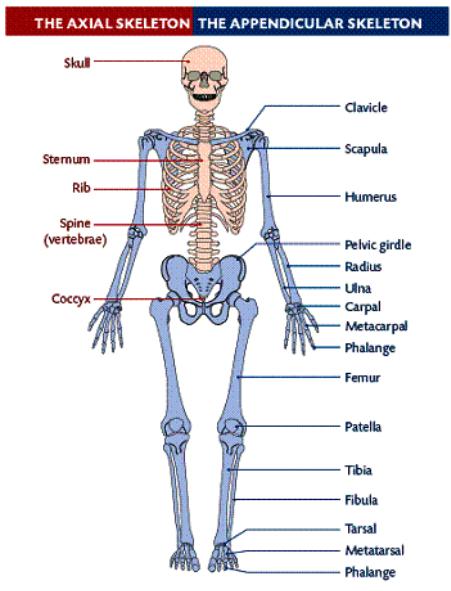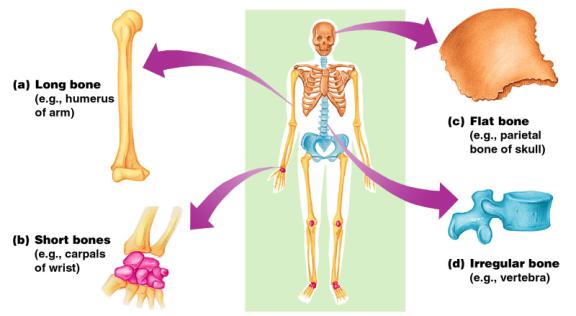
OSTEOLOGYKEY
.pdf
Osteology of the Human Body
Without the skeletal system, you would be unable to engage in activities such as walking or grasping objects in your hand. Since the skeleton forms the internal framework of the body, a familiarity with the names, shapes, and features of individual bones will help you understand some of the movements that the human body can perform.
1. Number and major subdivisions of bones
Average # of bones = 206
2 major subdivisions: Axial skeleton
Appendicular Skeleton (appendages)
1

2. Types of bones
a) long bones
*bones that are longer than they are wide *found only in appendicular skeleton *has a diaphysis and 2 ephiphyses
ex) humerus, radius, ulna, metacarpals, phlanges femur, tibia, fibula, metatarsals, phlanges
b) short bones
*bones that are roughly cube shaped or spheroid ex) carpals – wrist bones (8 per side)
tarsals – ankle bones (7 per side)
c) flat bones
*bones that are thin, flattened and somewhat curved
ex) ribs, sternum, scapula and many bones of the skull
d) irregular bones
*bones that do not fit into the above categories ex) vertebrae, hip bones, many bones of face
e) sesamoid bones
*short bone located within a tendon ex) patella
2
f) sutural bones
*small bones within a cranial suture *variable in number
*may or may not be present
3. Surface features of bones
*bones are not smooth
*have a variety of bumps, depressions and holes. *Most all features have a function
1.attachment site for ligament or tendon
2.tunnel for blood vessels and nerves
3.articulation to another bone
process: a very general term used for a part of a bone that sticks out or protrudes
a. Depressions or openings on bones
foramen
*a round or oval hole through a bone. Blood vessels and nerves pass through
ex) foramen magnum)
fossa
*a shallow depression on a bone ex) mandibular fossa
groove or sulcus
*a deep scratch or long, narrow depression on a bone
meatus
* a bony passageway through a bone ex) external auditory meatus
3
b. Processes where a bone articulates with another bone
condyle
*a smooth, rounded, knuckle-like projection ex) distal femur
*head
a bony expansion at the end of a bone. Often rounded or spherical
ex) proximal femur and proximal humerus
*trochlea
a pulley-shaped projection of bone ex) distal humerus
*facet
a small flat, smooth surface on a bone
ex) b/t vertebrae where they articulate with each other
c. Processes where a bone attaches to a tendon or ligament
crest
* a narrow, raised ridge of bone, usually quite prominent ex) iliac crest
line or linea
*a narrow raised ridge of bone, usually quite subtle ex) epiphyseal line
malleolus
*a blunt projection at the end of a bone. ex) distals ends of tibia and fibula
spine
*a sharp, slender, often pointed projected ex) scapula
trochanter
*a very large, blunt, irregularly-shaped lump of bone ex) two of proximal femur
4
tubercle
*a small, rounded projetion of bone ex) two at proximal humerus
tuberosity
*a large, rounded projection of bone ex) radial tuberosity
tibial tuberosity
THE AXIAL SKELETON
-forms the longitudinal axis of the body
-80 bones
-includes: 1) skull, 2) hyoid, 3) vertebral column, and 4) rib cage
4.The skull - (28 bones)
a) bony regions of skull
*subdivided into 3 regions: cranial bones
facial bones auditory ossicles
b) cranial bones (8) (cranium)
*bones that surround and protect the brain *either flat or irregular bones
parietal occupital temporal sphenoid frontial ethmoid
2
c) facial bones (14)
*bones that comprise the face *most are irregular bones
Functions:
Protect sensory organs (eye, nose, tongue)
Provide attachment sites for muscles of facial expression
Maxillary |
lacrimal |
plantine |
Nasal |
zygomatic |
nasal conchae |
|
|
Vomer |
|
|
mandible |
d) auditory ossicles (3 per side)
*Very small bones located within temporal bone. *All 3 are irregular bones
Function: transmit sound vibrations in middle ear Ex) malleus – hammer
Incus – anvil Stapes - stirrup
5. Hyoid (1 bone)
*a thin, u-shaped bone located interior to tongue. *Has no articulations to any other bone
Functions: |
Attachment site for muscles of tongue & neck |
|
Allows for speech |
3
6. Fontanels
*At birth, cranial bones do not touch one another. This allows flexibilith of skull during childbirth. It also allows for rapid growth of brain.
*These “soft spots” consist of skin and a sheet of connective tissue. Usually bones grow together and fontanel disappears by 1 year of age.
7. Cranial sutures
*Strong union between 2 neighboring cranial bones. *All involve parietal bone.
a)coronal - parietal bone unites with frontal bone
b)sagittal - 2 parietal bones unite on midline
c)lambdoidal- parietal bone unites with occipital bone.
d)squamosal – parietal one unites with temporal bone.
8. Vertebral column (26 bones) spine/backbone
Subdivided into 5 regions
Cervical |
(_____________) 7 bones |
Thoracic (_____________) 12 bones |
|
Lumbar |
(_____________) 5 bones |
Sacral |
(_____________) 5 fused vertebrae |
Coccxyeal (_____________) 3-5 fused bones
Functions:
1.protection of spinal cord
2.support weight of head and trunk
3.allows for movement of head, neck and trunk
4.site for many muscle attachments
4

9. Typical vertebra
10. Rib cage = Thoracic cage (25 bones)
*A cone –shaped bony cage that forms the chest. *Between adjacent ribs are intercostal muscles
Functions:
1.protection of heart and lungs
2.help process of breathing
a) sternum (1) (_____________)
*located on anterior midline of thoracic cage *articulates with: clavicle and ribs (1-7)
consists of 3 fused bones: manubrium (superior) body (middle)
xphoid process (inferior)
5
b) ribs (24)
*each rib is a thin, curved strip of bone *all are flat bones
*12 per side
posterior attachment: thoracic vertebrae
anterior attachment: costal cartilage (_____________)
3 types of ribs:
1.1-7 are True Ribs (each costal cartilage touches sternum)
2.8-10 are False Ribs (each costal cartilage touches another costal cartilage
3.11 & 12 Floating Ribs (no costal cartilage) floats in muscle.
QUIZ #1!
6
THE APPENDICULAR SKELETON
-comprised of the bones of the upper and lower extremities
-126 bones
-includes: 1) upper extremity, 2) lower extremity, and 3) pectoral and pelvic
girdles
11.Pectoral girdle (2 bones per side)
•Attaches upper extremity to ribcage and vertebral comumn
•forms the shoulder
Calvical
Anterior bone of girdle
Medial attachmentà sternum
Lateral attachment à scapula
Scapula
Posterior bone of girdle
Medial attachment à muscles to vertebral column Lateral Attachment à humerus and clavicle
12.Upper extremity (30 per side)
•Attachment to pectoral girdle forms shoulder joint o Head of humerus
o Glenoid cavity of scapula
•Series of 4 muscles stabilize the shoulder joint and permist movement of humerus
o Rotator cuff
A.Humerus
a.Largest and longest in Upper Extremity
B.Radius
a.Lateral bone of forearm & Ulna – medial bone of forearm
7
